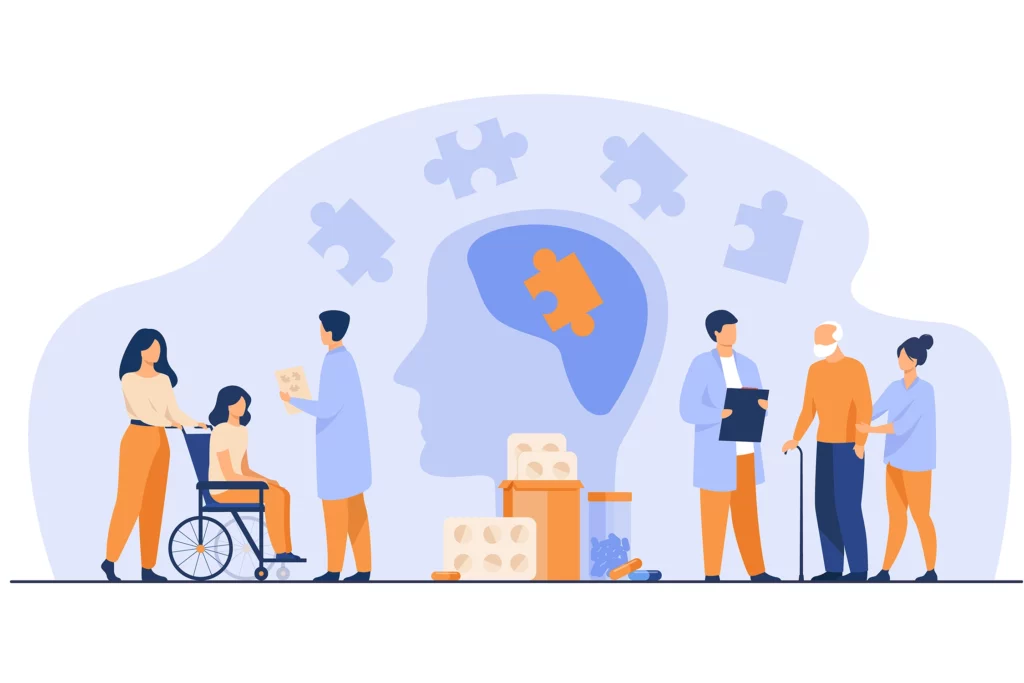
Early Signs of Lewy Body Dementia: Uncover the Clues
This post may contain affiliate links or Google Ads and we may earn a small commission when you click on the links at no additional cost to you. As an Amazon Affiliate, we earn from qualifying purchases. This is at no additional cost to you and helps with our website expenses.
Lewy Body Dementia (LBD) is a neurological disorder that can cause a wide range of symptoms. As with any disease, it is important to be aware of the early signs of Lewy Body Dementia so that diagnosis and treatment can begin as soon as possible.
Early Signs of Lewy Body Dementia Differ for Individuals
Recognizing the early signs may not always be easy, as they can differ from person to person. The early signs of Lewy Body Dementia can vary widely from person to person, as the disease affects different areas of the brain in each individual. Some symptoms may be more cognitive in nature, such as memory loss or difficulty concentrating, while others may be more physical, such as tremors or muscle rigidity.

Problems with Thinking and Comprehending
Progression in thinking problems such as difficulty with planning, decision-making, problem-solving, and memory loss.
Problems with planning can include difficulty creating and following a plan, making decisions in a timely manner, considering alternative solutions to problems, or managing time efficiently. Problem-solving can become challenging due to difficulty in understanding the cause-and-effect relationships or recognizing patterns in data.
Decision-making issues may manifest as difficulty understanding the consequences of one’s actions, making choices based on emotion rather than logic, or an inability to choose between two equally viable options.
Memory loss can lead to difficulties remembering facts and details, losing recently acquired information, or forgetting important appointments.
Additionally, it is common for those experiencing thinking and comprehension deficits to have trouble organizing their thoughts into coherent sentences when speaking or writing.
In the beginning stages of Lewy Body Dementia, these problems may be barely noticeable and attributed to just getting older. Individuals need to seek help if they are suffering from any of the issues listed above, as early intervention can make a huge difference in overall mental health and well-being and managing the disease.
Movement Problems are Typical Early Signs of Lewy Body Dementia
Movement problems such as tremors, stiffness, shuffling gait, and changes in facial expression or other motor abilities can occur early with LBD. Movement problems in Lewy Body Dementia can include tremors, stiffness, shuffling gait, and changes in facial expression or other motor abilities.
Stiffness may present as difficulty standing up or having difficulty changing position. Shuffling gait can also result in difficulty walking, as the steps may appear slow and uncoordinated. Facial expressions can manifest as having a “flat face”. The face doesn’t show emotion as the mouth may downturn and not be as animated as before.
These movement problems are symptoms similar to Parkinson’s disease, a neurological disorder that affects the central nervous system. Sometimes Parkinson’s disease and Lewy Body Dementia are diagnosed at close to the same time. Also, sometimes LBD is misdiagnosed as Parkinson’s.
Balance and Coordination
The first signs of Lewy Body Dementia also can manifest as issues with balance and coordination. These issues can range from a feeling of unsteadiness when walking to poor coordination in the hands and feet.
The loss of balance can be particularly noticeable and dangerous, as it may increase the risk of falls. As a result, those with Lewy Body Dementia may need assistance with activities that require good coordination or balance such as walking up stairs or standing up from a seated position.
With regular exercise and physical therapy, many people are able to maintain some degree of independence even when experiencing these symptoms.
Early Signs of Lewy Body Dementia include Cognitive and Behavioral Changes
In addition to difficulty with movement, those who suffer from Lewy Body Dementia often experience cognitive and behavioral changes. Memory difficulties, confusion and problems with concentration are all common in this form of dementia.
The cognitive and behavioral changes associated with Lewy Body Dementia often manifest differently in each individual. One common symptom is the inability to pay attention, which can lead to confusion when trying to follow conversations or instructions. Patients may also experience difficulty focusing on tasks, forgetfulness, and poor decision-making skills.
In terms of behavior, those suffering from Lewy Body Dementia may become anxious and possibly paranoid. They may also become more easily agitated and have difficulty expressing emotions appropriately. This can lead to mood swings and outbursts that can be difficult for families and caregivers to manage.
Families and caregivers need to remember that these behaviors are a result of the disease rather than intentional misbehavior.
Hallucinations are an Early Sign of Lewy Body Dementia
One of the key signs that differentiate LBD from other dementias is that hallucinations start early in the disease. Hallucinations are particularly common in people with Lewy Body Dementia and can take the form of seeing or hearing something that isn’t there.
These hallucinations may be visual, auditory, or tactile. Visual hallucinations may involve seeing people or objects that aren’t there, while auditory hallucinations may involve hearing voices or sounds that aren’t real. Tactile hallucinations refer to sensations such as feeling something crawling on their skin when nothing is actually present.
It’s important for family members and caregivers to be aware of these signs and seek medical help if they appear. There are medications that can help some people with hallucinations.
Sleep Disturbances
People with Lewy Body Dementia often experience difficulty falling asleep or staying asleep for long periods of time. These sleep disturbances can be caused by a variety of factors, including symptoms such as vivid dreams and nightmares, restlessness, and difficulty transitioning between stages of sleep. Additionally, daytime activities such as increased physical activity or exposure to bright light may also interfere with the sleep-wake cycle.
Contrary to not being able to sleep, some LBD patients sleep much more than normal and may have difficulty staying awake during the day. This is known as excessive sleepiness or hypersomnia.
Treatment for sleep disturbances in people with Lewy Body Dementia may include medications such as melatonin or non-pharmacological interventions such as establishing consistent bedtime routines and avoiding caffeine, nicotine, and alcohol close to bedtime. Additionally, consulting a healthcare provider about any underlying medical conditions may also be beneficial in helping to address and manage sleep disturbances.
It is important for caregivers of people with LBD to create a safe and comfortable sleeping environment, as well as engaging in relaxing activities such as reading or listening to calming music before going to bed. Additionally, receiving regular exercise during the day may help improve overall quality of sleep.
REM Sleep Behavior Disorder is one of the Early Signs of LBD
Long before a diagnosis of Lewy Body Dementia a person might have REM Sleep Behavior Disorder (RBD). This can start years or even decades before any other signs of LBD. People with RBD act out their dreams in a way that can be dangerous to them or those around them. They may yell, kick, punch or grab and if left untreated can cause serious injury to themselves or their bed partner.
Treatment for RBD includes medications such as Clonazepam, which helps reduce the movements while asleep. It is sometimes recommended that people with RBD sleep in a separate bed or room to avoid potential injury.
Mood Changes such as Depression, Anxiety, Apathy, Irritability or Agression
Early signs of Lewy Body Dementia include mood changes. These might be barely noticed at first but often increase as the disease progresses. People with Lewy Body Dementia may begin to experience depression, anxiety, apathy, irritability and aggression that can be difficult to manage.
Depression is often the earliest symptom of Lewy Body Dementia and can involve feelings of sadness, helplessness or hopelessness. Anxiety often occurs in tandem with depression and can manifest in physical symptoms such as heart palpitations and sweating. Apathy, or lack of motivation to do daily activities, is also common.
People with Lewy Body Dementia may become irritable and aggressive due to decreased cognitive functioning or agitation related to the disease. It’s important for individuals and their caregivers to be aware of these mood changes early on so that they can be managed properly.
Loss of Interest in Activities Formerly Enjoyed
In the early stages of LBD losing interest in activities might occur. For instance, if they enjoyed going out to dinner with friends or going to the movies, they may no longer want to participate in those activities. They might also lose interest in hobbies or other leisure activities that previously brought them joy.
This can be very difficult for both the individual and their caregivers to deal with as it is often accompanied by feelings of sadness and isolation. It’s important for caregivers to be patient, reassuring and supportive as the individual adjusts to their changing interests. Finding new activities that still provide stimulation and enjoyment can help keep them engaged and motivated.
Difficulty with Everyday Tasks
Lewy Body Dementia can cause difficulty with simple everyday tasks such as dressing, bathing or preparing meals. This is due in part to difficulty in recalling information or following steps. It can also be a result of problems with movement such as stiffness, tremors or gait instability.
It is important for caregivers to provide support and assistance when needed while still allowing the individual to do as much as they are safely able. Adaptations such as providing written instructions or simplifying tasks can help with the transition.
It is also important to be aware that this symptom can worsen as the disease progresses. It is essential to have a plan in place for more significant care needs so that everyone involved knows what to expect and how best to provide support.
Early diagnosis is key for treating Lewy Body Dementia. Treatment typically includes medications for managing specific symptoms and therapies designed to improve cognition and overall quality of life.
In conclusion: It is important to be aware of the early signs of Lewy Body Dementia so that diagnosis and treatment can begin as soon as possible. If you or someone you know is exhibiting any of the signs discussed, it is important to speak with a medical professional as soon as possible. With proper diagnosis and treatment, the progression of Lewy Body Dementia can be managed more appropriately.
This is not medical advice and only serves as educational content. Please consult your doctor for further queries.
What early signs of Lewy Body Dementia have you noticed, with yourself or your loved one? Let us know below.




